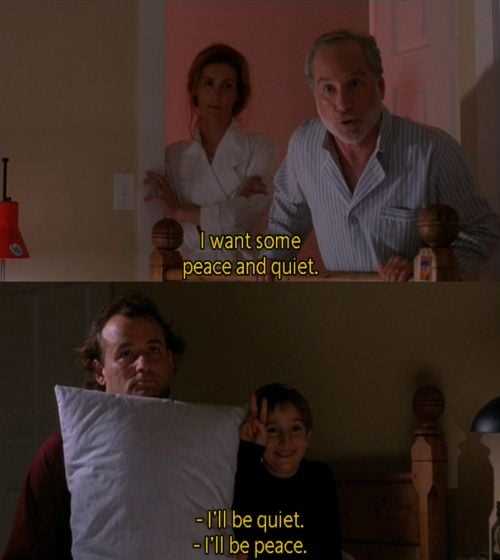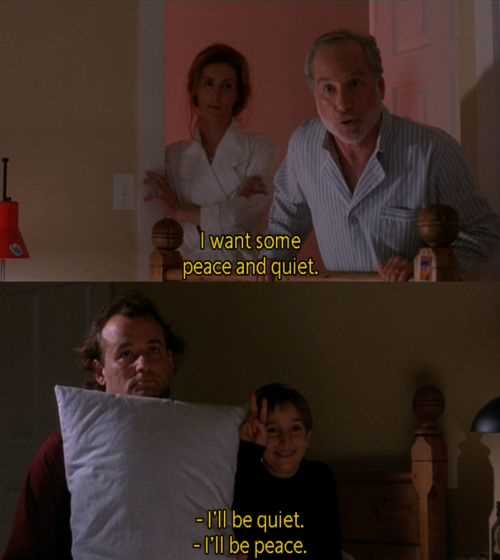“What About Bob” is a classic comedy film that has gained a cult following since its release in 1991. The movie stars Bill Murray as Bob Wiley, a neurotic and socially awkward patient who becomes attached to his new therapist, Dr. Leo Marvin, played by Richard Dreyfuss. The film is filled with hilarious and memorable quotes that have become iconic in the years since its release.
One of the most memorable quotes from the movie is when Bob exclaims, “I’m sailing!” This line is said as Bob triumphantly sets sail on a boat, symbolizing his newfound sense of freedom and accomplishment. The quote has become a popular catchphrase and is often used as a lighthearted way to express joy or success.
Another famous quote from the film is Dr. Marvin’s exasperated cry of “I’m baby-stepping!” This line is said as Dr. Marvin tries to teach Bob how to take small, manageable steps towards overcoming his fears and anxieties. The quote has become a popular phrase to describe the process of making progress in small increments.
One of the most inspiring quotes from the movie is when Bob says, “I feel good, I feel great, I feel wonderful!” This line is said as Bob embraces his newfound confidence and happiness. The quote has become a source of motivation and positivity for many, reminding us to focus on the good things in life and to embrace our own self-worth.
Overall, “What About Bob” is a comedy film filled with funny and inspiring quotes that have become beloved by fans. Whether you’re looking for a laugh or a boost of motivation, these lines from the movie are sure to bring a smile to your face.
Bob Wiley: A Comedic Genius
Bob Wiley, portrayed by Bill Murray in the movie “What About Bob,” is undeniably a comedic genius. His quirky and eccentric behavior, coupled with his hilarious one-liners, make him one of the most memorable characters in comedy film history.
Bob’s ability to deliver lines with impeccable timing and his physical comedy skills make him an absolute joy to watch on screen. Whether he is struggling with his overwhelming fear of almost everything or finding unique ways to cope with his anxiety, Bob never fails to leave the audience in stitches.
One of Bob’s comedic strengths lies in his ability to take ordinary situations and turn them into something hilarious. His interactions with his psychiatrist, Dr. Leo Marvin, played by Richard Dreyfuss, are particularly noteworthy in this regard. From his incessant need for affirmation to his insistence on following Dr. Marvin on his family vacation, Bob’s antics never fail to elicit laughter.
What sets Bob apart from other comedic characters is his relatability. Despite his extreme quirks, many viewers find themselves empathizing with him. We all have moments when we feel overwhelmed or anxious, and Bob’s ability to find humor in these situations is not only entertaining but also inspiring.
Bob’s deployment of comedic techniques such as self-deprecating humor and clever wordplay showcases his comedic genius. Whether he is joking about his own neuroses or coming up with hilarious one-liners, Bob’s humor is consistently on point.
Moreover, Bob’s comedic genius lies in his ability to make even the simplest of actions or statements absolutely hilarious. Whether it’s his insistence on saying “I need” instead of “I want,” his fascination with the word “baby steps,” or his unrelenting determination to conquer his fear of elevators, Bob finds humor in the mundane.
In conclusion, Bob Wiley, portrayed by Bill Murray in “What About Bob,” is a comedic genius whose one-liners and hilarious antics continue to entertain audiences to this day. His ability to find humor in everyday situations, coupled with his relatability, makes him a truly iconic comedic character. Whether you are in need of a good laugh or some inspiration, Bob Wiley and his antics will never disappoint. So, let’s all take some “baby steps” and embrace our inner Bob Wiley!
The Hilarity of Bob’s Phobias
In the classic comedy movie “What About Bob,” Bill Murray’s character Bob suffers from a variety of hilarious phobias. Throughout the film, these phobias provide comedic relief and inspire some of the most memorable lines. Here are a few examples of Bob’s phobias that made us laugh:
- Germs: Bob is extremely germophobic, constantly using hand sanitizer and avoiding touching anything he deems dirty. This phobia leads to hilarious scenes where he tries to navigate the world without coming into contact with germs.
- Elevators: Bob has an intense fear of elevators and prefers to take the stairs whenever possible. This fear leads to a comical scene where he attempts to climb the stairs of a multi-story building, exhausting himself in the process.
- Bladders: Bob has a phobia of urinating in public places, which leads to some awkward and amusing situations. In one scene, he attempts to urinate in a soda cup in the back of a moving car, much to the horror and amusement of the other passengers.
- Death: Bob has a fear of death, which is both hilarious and ironic considering his constant anxieties and panic attacks. This phobia is often played for laughs, with Bob imagining bizarre scenarios where he meets a tragic end.
The brilliance of Bob’s phobias lies in the way they are portrayed with humor and relatability. Each phobia creates absurd and ironic situations, and Bob’s reactions to them provide plenty of laughs throughout the film. Whether it’s his exaggerated fear of germs or his desperate attempts to avoid elevators, Bob’s phobias serve as a recurring source of humor and contribute to the film’s comedic charm.
If you’re looking for a movie that will make you laugh out loud, “What About Bob” is a must-watch. Bob’s phobias, along with Bill Murray’s hilarious performance, guarantee a delightful and entertaining experience.
Dr. Leo Marvin: A Frustrated Psychiatrist
Dr. Leo Marvin, portrayed by actor Richard Dreyfuss, is the frustrated psychiatrist in the movie “What About Bob?” who becomes increasingly aggravated by the antics of his patient, Bob Wiley. Throughout the film, Dr. Marvin’s attempts to maintain control and order are constantly thwarted by Bob’s relentless need for attention and approval.
As a successful psychiatrist and author, Dr. Marvin prides himself on his ability to help his patients and maintain a high level of professionalism. However, Bob’s persistent presence and his unorthodox methods of therapy push Dr. Marvin to the brink of madness. Despite being highly regarded by his colleagues and having a seemingly perfect life, Dr. Marvin’s interactions with Bob reveal the underlying frustration and insecurity within him.
Dr. Marvin’s frustration with Bob stems from his belief that he is in control of his own life and his patients. He is accustomed to being respected and taken seriously, but Bob’s relentless intrusion disrupts Dr. Marvin’s carefully constructed world. Throughout the film, Dr. Marvin’s attempts to rid himself of Bob become more desperate and extreme, but Bob always manages to find his way back into Dr. Marvin’s life.
Despite his frustration, Dr. Marvin does experience moments of insight and personal growth as a result of his interactions with Bob. As he becomes more assertive and confronts his own fears and insecurities, Dr. Marvin begins to understand the importance of embracing chaos and letting go of control. Bob serves as a catalyst for Dr. Marvin’s transformation, forcing him to confront his own limitations and reevaluate his approach to both his personal and professional life.
| Key Takeaways |
|---|
|
Memorable Quotes from the Movie
- Bob: I feel good, I feel great, I feel wonderful. I feel good, I feel great, I feel wonderful…
- Bob: I’m sailing! I’m a sailor! I sail!
- Bob: There are two types of people in this world: those who like Neil Diamond and those who don’t.
- Bob: Baby steps. It means setting small, reasonable goals for yourself, one day at a time.
- Bob: There’s no better way to overcome fear than to face it head-on.
- Bob: I’m disabled. I’ve got a note from my psychiatrist.
- Bob: Roses are red, violets are blue. I’m schizophrenic, and so am I.
- Leo: Hey Bob, there’s someone on the phone for you. Bob: Oh, really? Who is it? Leo: It’s the man! Bob: What man? Leo: The man who’s coming to take you away! Bob: Sounds like he needs a vacation!
- Dr. Leo Marvin: Bob, there is a very fine line between love and nausea.
- Bob: I really appreciate this talk, Dr. Marvin. I mean, I’m excited about this talk!
Note: These quotes are taken from the movie “What About Bob” and are meant to be funny and entertaining. Please enjoy them responsibly!
Bob’s Unorthodox Therapies
Bob, the main character in the movie “What About Bob”, may have been a bit unconventional in his approach to therapy, but his unorthodox methods often provided hilarious and unexpected results. Here are some of Bob’s memorable therapeutic techniques:
- Baby Steps: One of Bob’s most iconic phrases in the movie is “baby steps”. He encourages himself and others to break down tasks into small, manageable steps, which can help overcome anxiety and fear.
- Marinade Therapy: Bob suggests that people “marinate” in their problems, claiming that it helps to immerse oneself in the discomfort in order to eventually find relief. While this may seem strange, it promotes facing one’s fears head-on.
- Multi-Phobia Therapy: Bob introduces the concept of treating multiple phobias simultaneously, believing that by addressing one fear at a time, the overall fear level decreases. His unorthodox methods include carrying around a variety of stuffed animals to help cope with different fears.
- Aquatherapy: Bob demonstrates the power of water therapy when he jumps into the lake fully clothed during a family sailing trip. While it may not be the most conventional method of therapeutic relaxation, it certainly gets the point across!
- Role Reversal: Bob takes on Dr. Leo Marvin’s role in therapy sessions, attempting to help Leo face his own fears and insecurities. This role reversal challenges traditional therapist-patient dynamics but ultimately enables both characters to grow.
In conclusion, Bob’s unorthodox therapies in the movie “What About Bob” may be comedic and unconventional, but they often provide unexpected breakthroughs and personal growth. Sometimes, thinking outside the box can lead to incredible results, even in the world of therapy.
The Importance of Baby Steps
In the movie “What About Bob,” the character Bob Wiley, played by Bill Murray, teaches us about the importance of taking baby steps in life. While Bob’s methods may seem unconventional, his approach to personal growth can be highly effective.
Bob’s mantra of “baby steps” emphasizes the power of breaking down large goals into manageable tasks. This approach allows individuals to overcome feelings of overwhelm and take small, achievable actions towards their larger objectives.
One of the key lessons we can learn from Bob is that progress is progress, no matter how small. By focusing on the small steps and celebrating even the tiniest victories, individuals can stay motivated and build momentum towards their ultimate goals.
Bob’s baby steps philosophy also encourages individuals to embrace the process rather than solely focusing on the end result. By appreciating the journey, people can find joy, learn valuable lessons, and grow as individuals.
Beyond personal development, the concept of baby steps can also be applied to various areas of life, such as career advancement, education, and relationships. By taking small, consistent actions, individuals can make significant progress over time without feeling overwhelmed or discouraged.
To implement the baby steps approach in your own life, you can start by identifying your long-term goals and breaking them down into smaller, actionable tasks. Create a list or a plan that outlines the steps you need to take, and prioritize them based on importance and feasibility.
Remember, baby steps may seem insignificant at first, but they can lead to remarkable outcomes. Each small action you take brings you closer to your goals and helps you develop the confidence and skills needed to tackle more significant challenges.
Example of a Baby Steps Plan:
- Define your long-term goal (e.g., getting a promotion).
- Break the goal into smaller objectives (e.g., improving specific skills, networking).
- Create a timeline and set deadlines for each objective.
- Identify the first small step you can take towards the first objective (e.g., signing up for a course).
- Commit to taking that step within a specific timeframe (e.g., within the next week).
- Repeat the process for each subsequent step.
- Celebrate each completed step to stay motivated and build momentum.
By embracing the baby steps philosophy, you can overcome obstacles, achieve your goals, and enjoy the journey along the way, just like Bob Wiley in “What About Bob.” So, remember to take those small, but meaningful, steps towards your aspirations.
The Impact of “What About Bob” on Pop Culture
“What About Bob” is a film that has had a significant impact on pop culture since its release in 1991. The movie, directed by Frank Oz, starring Bill Murray and Richard Dreyfuss, has become a cult classic and has influenced various aspects of popular culture.
1. Catchphrases: “What About Bob” introduced several catchphrases that have since become part of everyday language. One of the most famous is Bob’s line, “I feel good, I feel great, I feel wonderful!” This quote has been used in numerous memes and references in popular culture.
2. Memorable scenes: The film’s memorable scenes have been referenced and parodied in other movies, TV shows, and even commercials. One of the most iconic scenes is when Bob uses a sandwich as an analogy to explain his fear of death. This scene has been recreated and referenced in various forms of media.
3. Bob Wiley’s character: Bob Wiley, played by Bill Murray, has become a beloved character in pop culture. His relatable quirks, neurotic tendencies, and humorous antics have made him a fan favorite. Bob’s character has inspired many other comedic performances in movies and television.
4. Psychiatry portrayal: “What About Bob” portrays psychiatry in a comedic and exaggerated way, which has influenced the way mental health professionals are sometimes depicted in popular culture. The film’s portrayal of therapy and the relationship between psychiatrist Dr. Leo Marvin (Richard Dreyfuss) and his patient Bob Wiley has been referenced in various comedies and sitcoms.
5. Inspiration for other films: The success of “What About Bob” has inspired other filmmakers to create similar movies with a focus on eccentric characters and comedic situations. This includes films like “Analyze This” and “What About Dick?”, which followed the blueprint set by “What About Bob” in terms of humor and character dynamics.
Overall, “What About Bob” has left a lasting impact on pop culture through its memorable quotes, influential scenes, beloved characters, and the way it portrays mental health. The film’s humour and relatable story have made it a timeless classic that continues to be celebrated and referenced in various forms of media.
Question and answer:
What is the movie “What About Bob” about?
The movie “What About Bob” is a comedy film about a man named Bob Wiley who has multiple phobias and becomes a patient of an egotistical and arrogant psychiatrist named Dr. Leo Marvin.
Who are the main characters in the movie?
The main characters in the movie are Bob Wiley, played by Bill Murray, and Dr. Leo Marvin, played by Richard Dreyfuss.
What are some funny quotes from the movie?
One funny quote from the movie is “I’m sailing! I’m sailing!” which Bob says when he jumps into the lake with his life jacket on. Another one is “I feel good, I feel great, I feel wonderful” which Bob repeats throughout the movie.
What are some inspiring quotes from the movie?
One inspiring quote from the movie is “Baby steps” which Bob uses as a mantra to overcome his fears. Another one is “I won’t rest until I’m completely emasculated” which shows Bob’s determination to succeed.
Who directed the movie “What About Bob”?
The movie “What About Bob” was directed by Frank Oz.
When was the movie “What About Bob” released?
The movie “What About Bob” was released on May 17, 1991.
What is the rating of the movie “What About Bob”?
The movie “What About Bob” has a rating of 7.1/10 on IMDb.


